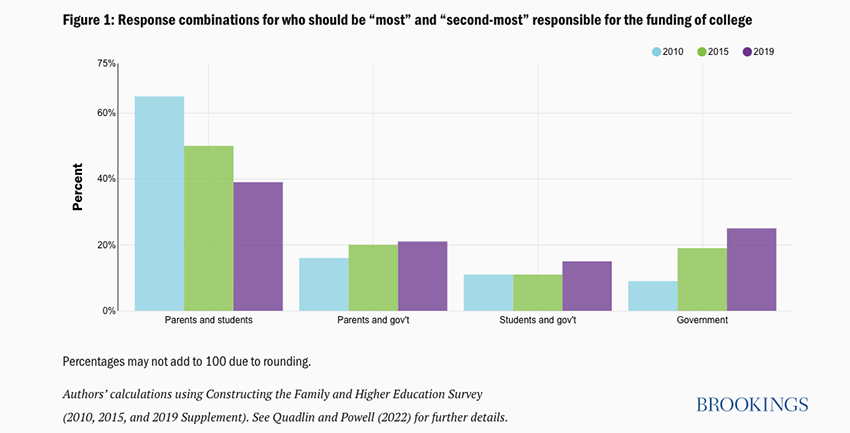The Brookings Institute has been asking nationally representative samples who should be paying for college since 2010. The graph shows the shift from what they characterize as the individualists (parents and students) to the more collectivist (parents and students in some combination with the government).

In 2010, 65% of respondents were for individually footing the bill; by 2015, 50%, and now, a majority are more collectivist, seeking a range of helping hands.
Moving public opinion is a daunting project. In most instances, public opinion changes due to “cohort replacement,” academic speak for those with older beliefs dying out and replaced by younger views. Brookings notes that a shift of this degree over ten years is remarkable. This makes me feel that politicians are leading- from behind, as is often the case.
As reported elsewhere,
“For the 2018-19 academic year in the U.S., annual prices for an undergraduate education averaged about $18,380 at public institutions and $47,420 at private nonprofit institutions — a 28% and 19% increase from 10 years prior, respectively. Most of these increases come from tuition and housing.”
Up until recently, those increases were five times the rate of inflation. Among the factors responsible for higher tuition are
- Life-style amenities for students – the dorm is no longer two beds and desks.
- Administrative costs – While faculty salaries remain stagnate and more and more faculty are part-time, the growth of administration operations has increased ten-fold.
- College growth – there is little doubt that a college education can increase your earning power over a lifetime. So, there is increased demand for spaces. That is unfortunately coupled with diminishing state support of their college systems. The shortfall lands on parents and students.
Of course, COVID’s shift of school from in-person to online has increased the questioning about what that tuition is really buying.
I was very fortunate; my parents covered the cost of my undergraduate and graduate school. As a physician, I could pay that forward to my children, who left college debt-free. I think that ability is far more limited today; according to the Brookings Institute, I am not alone in that belief. If a college education “lifts all boats,” isn’t there a way for us to act as one, reining in costs and reducing debt?
Source: Responsibility for the funding of college: Where does the public stand? Brookings Institute




